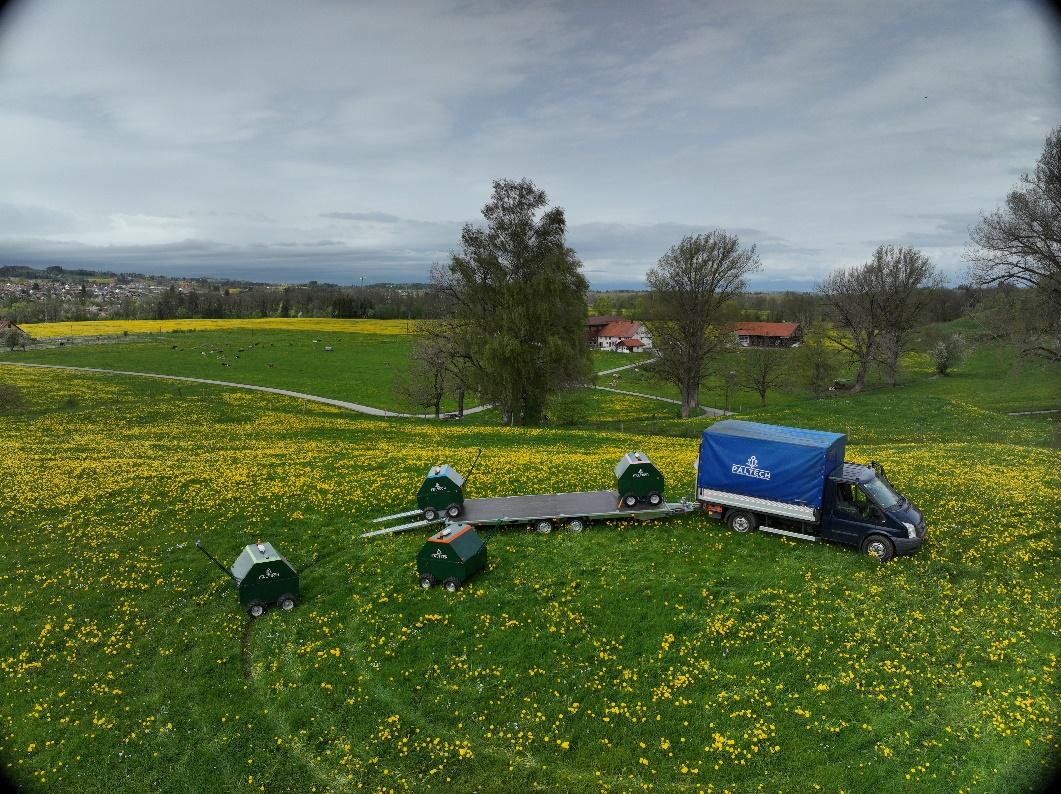Objectives of the service
Paltech’s service addresses these issues by eliminating the need for manual labor through a completely herbicide-free, mechanical extraction process. Utilizing space technology, the robotic fleet efficiently scours fields, targeting and removing weeds one by one.
The main problems of the users are related to the negative impact of dock (Rumex) on milk production. In addition, by adopting organic methods of maintenance, strenuous and time-consuming manual extraction processes are incurred, which consume large amounts of time and cause physical pain.
This project aims to validate the accuracy and efficiency of the GNSS-enhanced robotic weed detection and removal system, assess user satisfaction with the service—focusing on ease of use and reliability—and evaluate the environmental benefits of reduced herbicide use.

Users and their needs
The primary customers are organic german farmers, both dairy and horse farms, managing permanent grassland in Germany with nearly 85% of organic farmers managing grassland facing issues with dockweed.
-
Resource-Efficient Solutions: Farmers need organic weed control methods that are less resource-intensive in terms of water and energy usage.
-
Yield Optimization: Farmers need effective strategies to minimize the negative impact of Dock on yield to maintain or enhance milk production.
-
Livestock Safety: Farmers need reliable methods to prevent livestock from consuming Autumn crocus to avoid potential fatalities.
-
Efficient Weed Control: Farmers need less strenuous and time-consuming weed control methods to reduce physical strain and back pain.
-
Herbicide-Free Options: Farmers need effective, non-herbicidal weed management solutions to comply with organic farming regulations and maintain subsidies, such as Bavaria’s €273/ha.
Service/ system concept
The service starts with four robots, which are brought to the field and unloaded. Before the actual weed control begins, a drone flies over the field and takes pictures at strategic locations. These photos are used to detect and locate the weeds. Thanks to RTK positioning, this step may also have happened before (e.g. before cutting). This allows optimized routes to be calculated on which the robots travel and remove the weeds. Once a robot has reached the right spot, it positions itself over the plant and removes it. It then sows grass seeds to restore the turf and ensure sustainable control. Paltech adopts a Robots as a Service (RaaS) model, forging partnerships with contractors to address logistical challenges.
Space Added Value
Satellite-based positioning systems, particularly GNSS and RTK, significantly enhances a herbicide-free weed control solution. It ensures precise localization and navigation of the drone and the robotic fleet, since traditional weed control methods, such as manual labor or broad application techniques, often lack precision, leading to inefficiencies. With the local RTK base station the robots can ensure minimal positioning errors, allowing to bypass the need to build an orthomosaic with the drone images and passing on the positions of the detected weeds directly to the robots which can be time-consuming and resource-intensive.
This allows to tracing the weeds over the years and maximizing transparency, traditional methods often lack the capability to track weed growth and distribution over time, making long-term weed management less effective.
Finally, this allows to optimize the paths and maximizes efficiency, reducing operational time, this optimization translates to lower labor costs, reduced wear and tear on equipment, and faster completion of weed control tasks.
Current Status
The EM-GROW project is currently advancing toward the Factory Acceptance Test (FAT), with key technical components undergoing final integration and validation. Initial testing of the weeding mechanism, navigation system, and clean energy supply has been conducted on local test fields near Paltech’s facilities. Parallel efforts have focused on refining the customer portal and human-machine interface to support contractors and future pilot users.
To build awareness ahead of the pilot phase, EM-GROW was also presented at the Allgäuer Agrarschau, one of the region’s most relevant agricultural fairs. The event provided valuable stakeholder feedback and helped strengthen the project's visibility within its target user base. The upcoming FAT will serve as a formal milestone to confirm system readiness before entering operational deployment.



